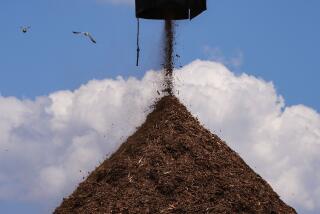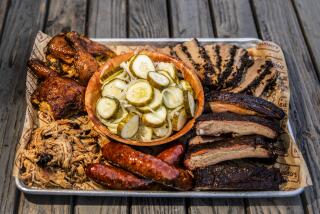Less-Polluting Barbecue Charcoal Is Developed
- Share via
LOS ANGELES — When the South Coast Air Quality Management District tookaim at back-yard barbecue pollution last year by introducing a low emission standard, critics labeled it an affront to an American tradition.
“Use a barbecue, go to jail,” was one battle cry.
The U.S. barbecue industry sued the district in an unsuccessful effort to kill the rule, saying the standard was unattainable.
But their concerns have proved to be unfounded.
Not only have charcoal manufacturers complied with the rule, two companies have developed an ultra-clean barbecue briquette that is 50 times less polluting than the standard allows.
Both products use a coal found in China and combine it with wood charcoal and an inorganic igniter to achieve the low emissions. Conventional charcoal, which contains no coal, is produced by heating wood at high temperatures without free oxygen.
Development of the self-lighting briquettes by Future Fuel in Rancho Cucamonga and Trans American Chemical Corp. of Tulsa, Okla., comes less than a year after the AQMD standard took effect and was roundly criticized by the industry.
Before the new standard was approved, the AQMD said that during the peak summer barbecuing season charcoal lighter fluid put out as much smog-forming volatile organic compounds as a medium-size oil refinery.
But the two products using coal have dramatically lower emissions than improved lighter fluids and other products developed to meet the AQMD standard.
Both companies said they hope to market their new briquettes in California by next spring or summer. Future Fuel is test-marketing its product in Florida.
Testing by the Center for Emissions Research & Analysis--an independent, nonprofit laboratory that the AQMD helped organize--found that emissions from Trans American Chemical’s Dragon Light Instant Charcoal Briquette beat the AQMD standard of 0.02 pounds of smog-forming compounds by 50 times.
A test by another lab hired by Future Fuel and certified by the AQMD as meeting its testing standards produced similar results for that company’s Bar-B-Bric Zap Light brick. Emissions from both products were pegged at .004 pounds of smog-forming compounds for each lighting.
Frank Huang, president of Trans American Chemical, which has ties with a government-run manufacturer in China, said his briquette is shaped like a cube with a hole in the center.
“When you light it, it has no odor and is smokeless,” Huang said. He said food barbecued with Dragon Light tastes no different than if cooked with conventional briquettes.
Tom Nightingale, vice president of marketing for Pacer Technology, the parent company of Future Fuel, said its product is fashioned into 5-inch-by-5-inch bricks. In both cases, cooking can begin about three minutes after the product is ignited.
More to Read
Sign up for Essential California
The most important California stories and recommendations in your inbox every morning.
You may occasionally receive promotional content from the Los Angeles Times.










